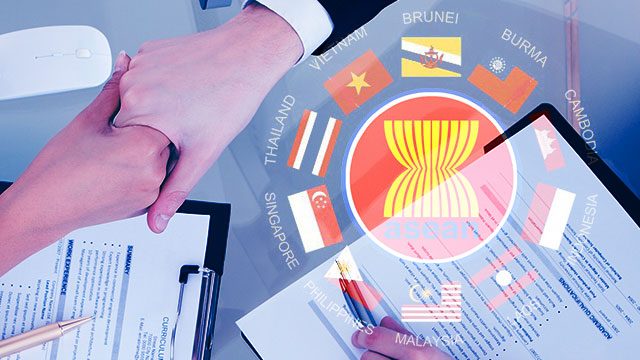SUMMARY
This is AI generated summarization, which may have errors. For context, always refer to the full article.

MANILA, Philippines – “It’s like an unexpected present wrapped in brightly colored paper: It looks very nice, but you don’t really know what’s in it.”
This is how Philippine Long Distance Telephone Company (PLDT) president and CEO Napoleon Nazareno described the planned economic integration of the Association of Southeast Asian Nations (ASEAN) by 2015.
The ASEAN Economic Community (AEC) envisions the free movement of goods, services, investment, skilled labor, and freer flow of capital among the 10 ASEAN member states: Brunei Darussalam, Cambodia, Lao PDR, Indonesia, Malaysia, Myanmar, the Philippines, Singapore, Thailand, and Vietnam.
Nazareno said AEC is double-edged as it presents both risks and opportunities.
In his speech on the first day of the 2nd Asian Business Conference Thursday, June 26, Nazareno cited the vulnerability of Philippine agriculture and small and medium enterprise (SME) sectors to the AEC. SME development is one of the two priorities under the AEC’s equitable economic development plan. (READ: ‘Agri, SME sectors not ready for ASEAN integration’)
Nazareno also said that governments still have so much to do in terms of enacting enabling legislation and putting in place needed institutional reforms.
“The provisions outlined in the AEC blueprint and related agreements require modifications to domestic laws. Delays in the implementation of these changes may put a country at a disadvantage,” he said.
A lot remains to be done to eliminate trade barriers such as the lack of physical infrastructure and non-standard regulatory policies, Nazareno said.
SMEs, agriculture at risk
On the other hand, there is the prospect of ASEAN companies gaining access to a regional market for their goods and services. Such will lower costs and raise revenues for these companies, making them more internationally competitive than if they focused solely on their respective national markets, Nazareno said.
Citing a recent Deutsche Bank study, Nazareno said there is the risk that margins may come under pressure due to increased competition as ASEAN companies jostle for space in each other’s markets.
The companies that face the most risk are small enterprises that do not have sufficient resources to expand their regional presence, Nazareno pointed out.
The dangers of opening up markets are particularly visible in the case of Philippine agriculture, Nazareno said.
“Filipino farmers have been reminded of this by the recent misfortunes of crops like rice, garlic, and coconut, which highlight the vulnerabilities of Philippine farming to competition from ASEAN neighbors,” Nazareno said. (READ: Machines on PH farms: Catching up with ASEAN integration)
The private sector needs to prepare for an integrated ASEAN market, he pointed out.
But as cited by businessmen at the Asian Economic Congress held in Jakarta last April, there is a need to educate businesses most especially SMEs. (READ: ‘ASEAN integration an opportunity, not a threat to PH SMEs’)
While AEC’s success rests on the assumption that all the ASEAN member states have done their homework and diligently prepared for the setting up of a single market, “this is a generous assumption given that ASEAN does not have an enforcement mechanism to check on member compliance,” Nazareno said.
Foreign ownership
Meanwhile, in order to fully integrate with ASEAN neighbors, economist Cielito Habito said the Philippines has to open up its investment policy, particularly in the services sector.
At the National Competitiveness Council Dialogue, “Getting Ready for AEC 2015,” Thursday, Habito said the AEC framework calls for at least 70% ASEAN ownership in professional and financial services.
“That is yet to be done to a large extent because of constitutional restrictions,” he said.
He also urged the National Economic and Development Authority to look at the restrictions in the Foreign Investment Negative List. “Ideally if we can open up the (investment) environment the way the neighbors have, we can unleash much more FDI (foreign direct investment).”
He said that while FDI into the Philippines has almost quadrupled per year from $1 billion to $3.9 billion, countries in the region are
averaging about $6 billion.
“There is real constraint because of the basic law. It all boils down to more openness,” he said. – Rappler.com
Add a comment
How does this make you feel?
There are no comments yet. Add your comment to start the conversation.